ISPs Struggled with the FCC’s Inaugural Broadband Data Collection Process
Following are the results from a survey I conducted of broadband service providers related to the new FCC mandate for biannual reporting of broadband availability data in the Broadband Data Collection System.
First, let me provide a little background on what this is all about. The Broadband Data Act requires the FCC to create a new broadband map that is an accurate representation of broadband availability for every location where broadband service should be available. In order to accomplish this, the first thing the FCC had to do under the Act was create a Broadband Serviceable Location Fabric (“Fabric”) that contains the geographic coordinates of every structure in the U.S. where broadband service should be available (“broadband serviceable locations”). Next, the FCC mandated that all broadband providers twice a year complete a filing that includes any broadband serviceable locations in their area where they can provide service with a standard installation, which would mean a routine installation that requires “no charges or delays attributable to the extension of the network of the provider”. The combination of the operator’s service area data overlaid on the Fabric data is what will be used to generate the new and much improved broadband availability map.
The first filing window for service providers to upload their serviceable locations was June 30th through September 1st, with the next filing window being January through June of next year. So, the deadline has now passed on the inaugural filing, although as of this writing the FCC is still accepting submissions.
I had heard that providers were having a difficult time completing their submission, and I had already suspected that might be the case because of the required process to match the addresses in areas they could provide service with the Location IDs in the FCC’s Fabric. In addition, I had heard that the Fabric data itself was not accurate.
I decided to send a survey of broadband operators to get an idea of how they were doing with the filing, including whether they had completed their filing, whether they thought they would be able to complete it by the deadline, and what challenges, if any, they had with formatting or submitting their broadband coverage data. I conducted the survey during the last week of the filing period (August 26th through September 1st) and received 41 responses from operators of various sizes. Following are the aggregate results I received.
The first question asked the operator was to estimate the approximate number of broadband serviceable locations on their network (homes and businesses passed). Following is a breakdown of that data. While two operators did not answer the question, you can see that service providers of various sizes responded, with the majority (33) being under 20,000 serviceable locations. The smallest operator who responded has 224 locations, and the largest has over 547,000. It’s not surprising that there are fewer large operators represented, since it is harder to target the person or persons who would be responsible for handling the filing.
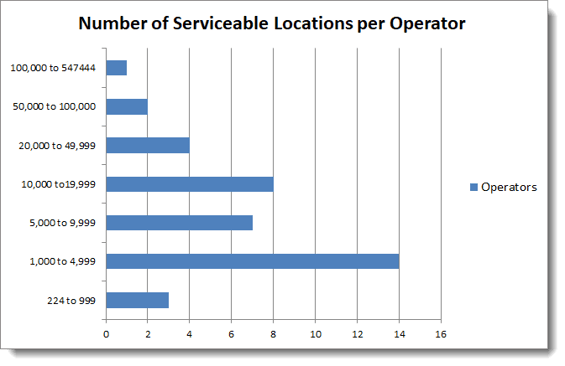
Following are the other questions asked, and a summary of responses received.
Q. Have you successfully completed and submitted your Broadband Data Collection filing?
This was a Yes or No answer. As you can see, a majority of operators had not yet completed their filing. It’s important to note that a good number of these answers were submitted early during the survey week, however, keep in mind that this was the last week prior to the filing deadline. I do have a breakdown in a section below where I drill into how these operators answered this question based on the date that they answered the survey.
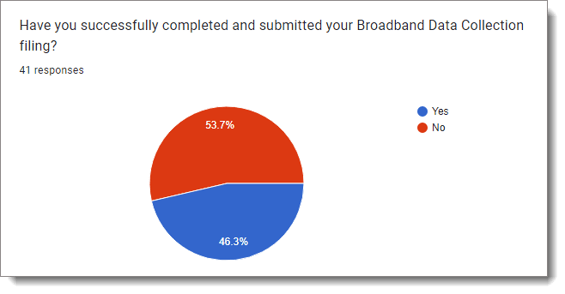
Q. What process did you use or are you using to format and upload your coverage data?
There are two ways that operators can format their location data so it will sync up with the FCC’s Location IDs. One is to do text matching between a CSV file that the operator creates that contains their serviceable addresses with the Fabric CSV file that contains all broadband serviceable locations. The Fabric includes addresses and corresponding Location IDs. The operator is required to only include the Location IDs in their filing, not addresses.
The other option is for the operator to use GIS software to view the locations in the Fabric and then draw polygons around the broadband serviceable locations on the map indicating the locations they serve. You can see that most operators (46%) used or were attempting to use text matching between the data in the CSVs. However, during this survey period over 24% had still not determined which method they were going to use.

Q. What has been the biggest challenge in completing the filing?
These were options for answering this question, since you cannot see the full text on the chart image:
- Determining what information I need to submit.
- Identifying all of the addresses where I can provide broadband service.
- How to match my addresses with the Location IDs in the Broadband Serviceable Location Fabric.
- How to create polygon files with my location data along with the other required information.
- Inaccuracy or incompleteness of the Serviceable Locations in the Broadband Fabric.
- Technical issues with the Broadband Data Collection System website.
- Other [with a place for short answer with more details]
As you can see below, the biggest challenge was the operator matching their available service addresses with the addresses and Location IDs in the Fabric, followed closely by inaccuracy or incompleteness of the Fabric data. There could be some overlap there, in that inaccurate data or address data with slight format differences could fall in either of those categories, but obviously, syncing up the data for one reason or another was a problem for the majority of operators.
Surprisingly, 17% said the biggest challenge was determining what information to submit. The required information and the format of that information was clearly defined on the FCC help site, so this leads me to believe that several operators had left this process to the last minute, and some were possibly not even aware until late in the filing window that this needed to be done. Larger operators would have been more likely to be on top of the requirement, and more likely to use a GIS system and polygons to report their serviceable areas, while I suspect the smaller operators struggled with text matching of the data in Excel.
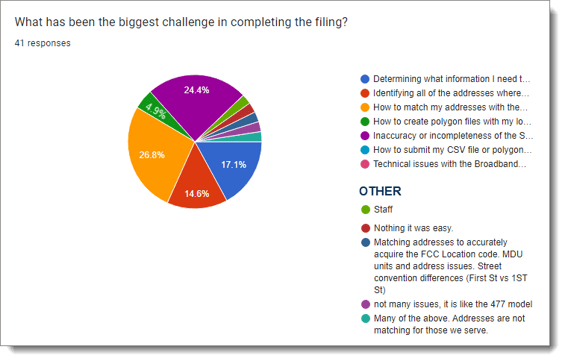
Q. Do you anticipate completing the filing before the September 1st deadline?
We started the survey by asking if they had already completed their filing, and ended with whether they expected to complete it by the deadline. We can assume that those who already had completed their filing answered “Yes” to this question also. Their answer to this question would also be impacted by when the operator completed the survey during that final week. There is also a breakdown below showing that information. At the time this question was answered, 41.5% were either not yet sure they would complete their filing or did not expect to, with the latter category making up almost 10% of respondents.
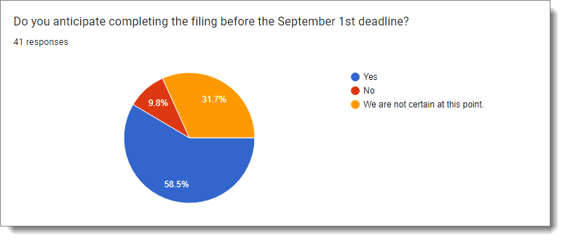
As mentioned, I drilled into the data further to see how the two questions about completion of the filing tracked with when the survey was answered. These next two charts show how operators answered those questions based on the date they answered the survey.
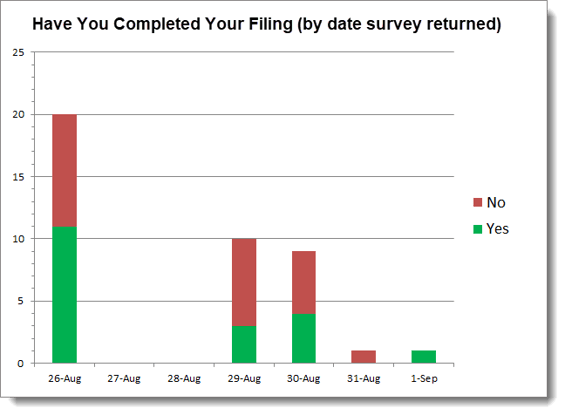
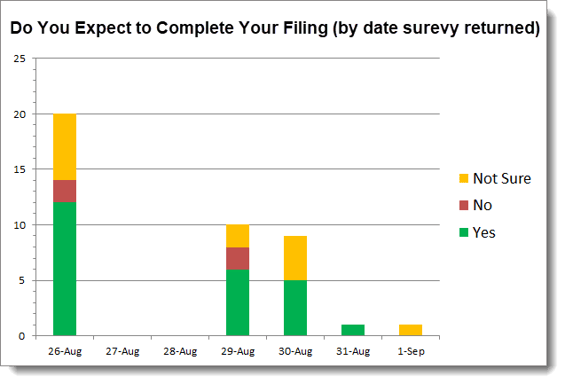
Finally, these last two charts show a breakdown of those same two questions based on the number of locations each operator had.

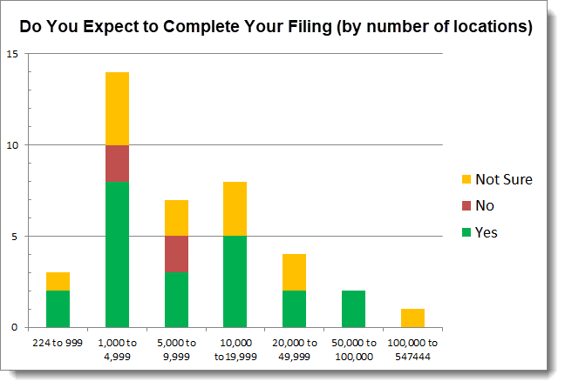
The data from this survey clearly shows that broadband providers of different sizes were struggling with completing their filing. We can assume that larger operators were able to get their filing in on time. They have more resources to throw at the project, and would be more likely to use a GIS system and polygons to identify their service areas, which would remove the obstacle of text matching. However, we can also assume that they had issues with syncing up some of their data in areas where the service addresses and Location IDs in the Fabric are wrong or incomplete.
The challenge process is now open, which allows State, local, and Tribal governments, service providers, and other entities to file bulk challenges to the data in the Fabric. For more information on that challenge process you can watch this video.
About the Author: Rick Yuzzi

Never miss a post.
Enter your email to subscribe:
- Ask an Expert (12)
- Blog (12)
- Technology (11)
- Hot Topics (8)
- ask a broadband expert (8)
- DOCSIS (7)
- PNM (7)
- proactive network maintenance (7)
- Industry Perspectives (5)
- BEAD (4)
- Broadband Funding (4)
- Customer Service (4)
- FCC (4)
- IIJA (4)
- PreEqualization Analyzer (4)
- correlation groups (4)
- fiber broadband (4)
- fiber optics (4)
- fiber troubleshooting (4)
- interview (4)
- CGNAT (3)
- Carrier Grade NAT (3)
- DDoS Attacks (3)
- DOCSIS pre-equalization (3)
- Diagnostics (3)
- Distributed Denial of Service Attacks (3)
- GPoN (3)
- IPv4 Conservation (3)
- Purchase IPv4 Addresses (3)
- What is DOCSIS PNM (3)
- broadband infrastructure funding (3)
- fiber (3)
- 5G (2)
- CALEA (2)
- CALEA Compliance (2)
- Codeword Errors (2)
- DOCSIS 3.1 (2)
- Distributed Access Architecture (2)
- Group Delay (2)
- ICFR (2)
- IP traffic (2)
- IPv6 migration (2)
- In Channel Frequency Response (2)
- Main Tap Compression (2)
- Marketing (2)
- Micro Reflections (2)
- Millimeter Wave (2)
- OTT (2)
- Rural Broadband (2)
- Types of DDoS Attacks (2)
- Voice Service (2)
- XGS-PON (2)
- broadband data collection (2)
- customer service (2)
- internet issues (2)
- mid-band spectrum (2)
- mmWave (2)
- network traffic (2)
- network virtualization (2)
- state broadband (2)
- state broadband program (2)
- weather-related Internet issues (2)
- 10G (1)
- BDC (1)
- BDC Availability Data Specification (1)
- BDC User Guide (1)
- BEAD Funding (1)
- Broadband Providers (1)
- Broadband Serviceable Location Fabric (1)
- Broadband Serviceable Locations (1)
- C-Band (1)
- CA Certificate Expiration (1)
- CAF II Requirements (1)
- CAF II Testing (1)
- CALEA SSI Plan (1)
- CBRS (1)
- Carpet Bombing (1)
- Citizens Broadband Radio (1)
- Communications Assistance for Law Enforcement Act (1)
- Connect America Fund (1)
- DAA (1)
- DOCSIS 4.0 (1)
- DOCSIS CA Certificate Expiration (1)
- DPoE (1)
- DPoG (1)
- EPoN (1)
- Excel Text Matching (1)
- Extended Spectrum DOCSIS (1)
- Extending HFC Life (1)
- FCC Broadband Map (1)
- FCC data (1)
- FTTH (1)
- FTTx (1)
- Fidelity Communications (1)
- Full Duplex (1)
- Greenfield Broadband (1)
- Hosted VoIP (1)
- IPTV (1)
- IPv4 (1)
- IPv6 (1)
- IPv6 Transition Plan (1)
- LTE (1)
- Low Latency DOCSIS (1)
- MAC/PHY (1)
- Mobile (1)
- Monitoring (1)
- Motivation for DDoS Attacks (1)
- Multi-Vector DDoS Attacks (1)
- NG-PON2 (1)
- NIST (1)
- NIST Cybersecurity Framework (1)
- NIST requirements (1)
- NetFlow (1)
- Network Traffic Management, (1)
- OTT video streaming (1)
- Private Access License (PAL) (1)
- RDOF Auction (1)
- RDOF Voice Requirements (1)
- Remote MAC/PHY (1)
- Remote PHY (1)
- Robocalls (1)
- Rural Broadband Network Advancement Act (1)
- Rural Digital Opportunity Fund (1)
- SSI (1)
- STIR/SHAKEN (1)
- Small Cells (1)
- Streaming (1)
- System Security and Integrity Plan (1)
- TV Viewership Analytics (1)
- TWDM-PON (1)
- TruVizion (1)
- Underserved Locations (1)
- Unserved Locations (1)
- Upstream Analyzer (1)
- Videos (1)
- VoIP (1)
- VoIP revenue (1)
- Wired Broadband (1)
- broadband data collection program (1)
- broadband deployment (1)
- broadband support (1)
- cableLabs (1)
- caf ii (1)
- case study (1)
- cloud-based VoIP (1)
- commercial VoIP (1)
- commercial VoIP revenue (1)
- cpe spectrum capture (1)
- customer service tip (1)
- cyber attacks (1)
- cybersecurity (1)
- dhcp (1)
- downstream spectrum issues (1)
- dual stack implementation (1)
- dynamic spectrum sharing (1)
- electric membership cooperatives (1)
- fiber Internet (1)
- fiber deployment (1)
- forward path monitoring (1)
- free download (1)
- full band capture (1)
- holiday customer service (1)
- holiday tech support (1)
- ingress (1)
- middle mile grant program (1)
- net neutrality (1)
- open access fiber (1)
- open access fiber network (1)
- open access networks (1)
- pppoa (1)
- pppoe (1)
- pre-equalization (1)
- reduced maintenance costs (1)
- remote spectrum analyzer (1)
- return path (1)
- scott helms (1)
- technical paper (1)
- technical support (1)
- vTDR (1)
.
About the Blog
Bloggers
Comments Policy
Guest Blogging
Privacy Policy

Leave a comment: